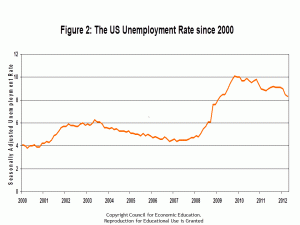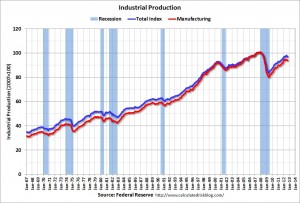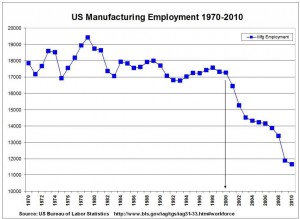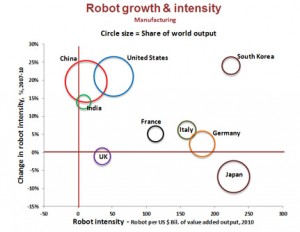It is a well known fact that the US is suffering from high unemployment and under-employment. This fact creates a host of social problems: it exacerbates poverty, increases inequality, weakens workers’ bargaining hand when looking for jobs and generates social unrest.
There is another well known fact: part of the reason the US is suffering from such high unemployment is that it has outsourced its manufacturing base to other countries, especially China.
The difference between these two facts is that the latter is false.
The US has not seen a big de-industrialisation and a consequent large scale outsourcing of jobs. Instead a long-term trend has been making itself known, and which threatens to accelerate. It is a trend of increasing manufacturing output which does not rely on humans.
The reason the myth of de-industrialisation is so widely accepted is that it dove-tails nicely with peoples’ personal experience. Many people would have known someone in manufacturing in the US during the 1970s, if they weren’t involved in it themselves. Television shows such as Laverne & Shirley glorified manufacturing of a prior period — a hint that there were already structural changes occurring. Now there is quite a small percentage of the population involved in manufacturing.
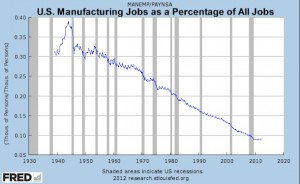
There really has been a vast decrease in the number of manufacturing jobs in the US. We see, between 1970 and 2012 the manufacturing workforce cut nearly in half. During this same period there has been a big increase in manufacturing output. In fact, despite NAFTA, despite the current recession, the manufacturing in 2012 exceeds the manufacturing output of 2000.
Now, the world recession will of course impact total manufacturing output in the US as well as in other countries. Total aggregate demand will be reduced if you have high unemployment with no other offsetting features. Yet we are already seeing a return to high levels of manufacturing output despite this.
Of Chinese Elephants
The elephant in the room is automation. It’s not that Chinese workers which are taking people’s jobs and causing an increase in unemployment. In a very real sense it is robots which are taking people’s jobs.
China itself is not immune to this increase in automation. In fact, the Guangdong-Fujian region has seen a labour supply shortage. This allows workers to combine, often informally, to drive up wages. The labour supply is expected to be stagnant or decrease through 2021.
None of this has been lost on companies like Foxconn who have historically relied heavily on these high levels of cheap labour. In 2011 Foxconn announced that it would be acquiring 1 million robots to replace labour. Foxconn of course has not been able to pursue this policy of automation without difficulties, but the tightening labour pool leaves them little freedom. Neither is Foxconn peculiar. Sales of robots to China increased an astounding 400% between 2006 and 2011.
We are the Robots
Recently two economists at MIT have written a book, “Race Against the Machine” which persuasively makes the case that automation is continuing the advance. However, it is not just manufacturing jobs which are being eliminated. Areas which formerly were considered middle class office jobs are also being rapidly eliminated.
It is not hard to imagine a future in which taxis and buses are driven by robots, indeed the technology to do so already exists. It is not hard to imagine that much of customer interactions could be eliminated in favour of computer interfaces in the service sectors, and we see this trend already happening.
There are few areas in which humans will continue to be needed. Somewhat ironically, the areas most difficult to automate are often at the extreme ends – either highly manual jobs like mechanical repair, janitorial work and laundry, or scientific and creative labour.
Full Employment or Empty Employment
This situation creates a very serious problem for people who have the opportunity to be living under advanced capitalism. If the capacity to be employed, even in the services sector, is under continuous attack by automation then how can we get a return to employment? If we can’t get a return to employment, how can people be paid enough to survive? If we are increasing our capacity of producing everything while simultaneously reducing our ability to consume it, something has to give.
There are probably intermediate ways out of the problem. We can institute a 25 hour week as we did the 40 hour week before. We could institute a universal wage. We could expand public production in areas which were previously much smaller such as arts. Yet all of this presupposes a political group with the capacity to achieve these demands.
Unemployment after WWII was seen as very dangerous, having been one of the precipitating factors which lead to the rise of fascism, and governments had express policies to avoid it becoming too high. This, combined with other geo-political factors such as the ever present threat of communism, made workers a powerful political force. Consequently the post-war “social democratic” period saw a rise in living standards, production and the welfare state all in the context of capitalism.
Now we have the problem of unemployment looming as a structural feature and the political agent who might change this fact is hidden. It would be a great and tragic irony if we could not find a way to utilise our productive capacity to satisfy our own needs merely because our current economic system precludes it.

